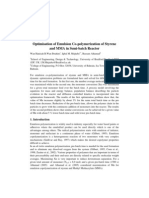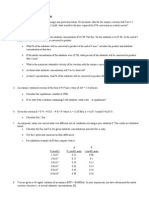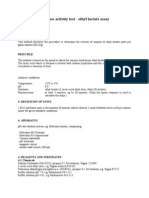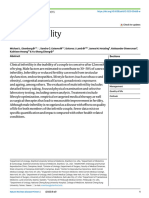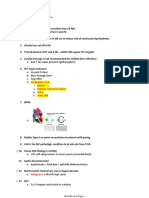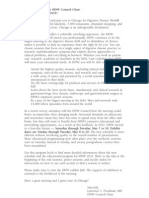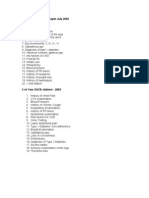ATPase
ATPase
Uploaded by
Devin MaaCopyright:
Available Formats
ATPase
ATPase
Uploaded by
Devin MaaCopyright
Available Formats
Share this document
Did you find this document useful?
Is this content inappropriate?
Copyright:
Available Formats
ATPase
ATPase
Uploaded by
Devin MaaCopyright:
Available Formats
1).
In a competitive inhibition experiment a
structural analog was used along with the
substrate and the following kinetics was
observed:
At 10M substrate the velocity was 25 M/min.
With 2mM of the analog the velocity dropped
to 50%. Calculate the Ki of the inhibitor.
Given that the substrate concentration used
gives half-maximal velocity. Calculate how
much inhibitor should be used for increasing
the Km to 10 times the uninhibited value?
%) 50 (
min
5 . 12 , ...... 2000 2
) (
min
25 ....... 10 ).
= => =
= =
inhibition with
M
v velocity M mM i
inhibition without
M
velocity M s a
???
10
min
50
2
...... 10 @ ... .
=
=
. =
= => = =
I
M
M
m
m
K
M K
K s when only
M
v
v
velocity M s T G
s
K
i
K
s v
v
Inhibition e Competitiv
I
M
m
+
(
+
=
1
.....
M K
I
1000 =
M i
M
K
I
K
i
M
K
9000
10 1
= ==>
=
(
(
+
? 10 ).
*
= > = i
M
K K if b
M
2).(Shuler3.7) An enzyme ATPase has a molecular weight of 5x10
4
Daltons, a
Km value of 10
-4
M and a k
3
(rate constant for product formation) value of
10
4
molecules ATP/min molecule enzyme at 37C . The reaction catalysed
is the following:
ATPase
ATP ADP + Pi
which can be also be represented as
E + S ES E + P
where S is ATP. The enzyme at this temperature is unstable. The enzyme
inactivation kinetics are first order:
E =Eo EXP (-k
d
t)
where E
o
is the initial enzyme concentration and k
d
= 0.1min
-1
.
In an experiment with a partially pure enzyme preparation , 10g of
total crude protein (containing enzyme) is added to a 1 ml reaction mixture
containing 0.02M ATP and incubated at 37C. After 12 hours the reaction
ends (i.e., t ) and the inorganic phosphate (P
i
) concentration is found to
be 0.002M, which was initially zero. What fraction of the crude protein
preparation was the enzyme?
Hint: Since [S] >> Km, the reaction rate can be represented by
] [
] [
3
E k
dt
P d
=
) exp( ] [
0 3 3
t k E k E k
dt
dp
d
==> =
% 10 1 . 0
10
1
1 10 1
10 5 10 10 2
6
4 3 8
==> = =
==> ==>
=>
g
g
protein crude in enzyme of Fraction
g g x
mol
g
x lt
lt
mol
x
| | M x E x E
dt t k E k dp
d
8
0
1
0
4
720
0
0 3
002 . 0
0
10 2 1 ) 720 1 . 0 exp(
min 1 . 0
1
min
10
002 . 0
) exp(
= ==>
=
=
} }
} }
=
720
0
0 3
002 . 0
0
) exp( dt t k E k dp
d
i). What type of inhibition is this?
ii). Determine the constants Vm, Km, and Ksi.
iii). Determine the oxidation rate at [S] = 70 mg/l.
S(mg/l) 10 20 30 50 60 80 90 110 130 140 150
Rate, V (mg/l.
h)
5 7.5 10 12.5 13.7 15 15 12.5 9.57 7.5 5.7
3. The following data were obtained from enzymatic
oxidation of phenol oxidase at different phenol
concentrations.
Plot v vs s-----Substrate Inhibition
Plot 1/v vs 1/s..find K
M
and Vm.since at
low substrate concentration no substrate
inhibition
?? = ==>
=
I
I M opt
K
K K s know we
?? ' '
2
= ==>
+ +
= = v
K
s
s K
s v
v in s sub
s
M
m
4. What is the turn-over number of 10-6M
solution of Carbonic anhydrase catalyses the
formation of 0.6M H
2
CO
3
per second when it is
fully saturated with substrate?
??
0
= =
e
v
k Number over Turn
m
cat
[S]mol / l 5 x 10
-4
2 x 10
-4
6 x 10
-5
4 x 10
-5
3 x 10
-5
2 x 10
-
5
1.6 x 10
-5
1.0 x 10
-5
8 x 10
-6
V(mol /
min)
125 125 121 111 96.5 62.5 42.7 13.9 7.5
5. The following data were obtained for an enzyme-
catalyzed reaction. Determine Vm and Km by inspection.
Plot the data using the Eadie-Hofstee method and
determine these constants graphically. Explain the
discrepancy in your two determinations. The initial rate
data for the enzyme-catalyzed reaction are as follows:
Do these data fit into Michaelis-Menten kinetics? If
not, what kind of rate expression would you suggest?
Use graphical methods.
Eadie Hofstee Plot
0
20
40
60
80
100
120
140
0 0.5 1 1.5 2 2.5 3 3.5
V
V
/
S
By inspection Vm =125 micromole/min
Km = 20 micromole / l
Eadie Hoftsee plot
y = -8.2507x + 130.36
0
20
40
60
80
100
120
140
0 1 2 3 4
V/S
V Slope = Km=8.25micromole / l
Vm= 130.36 micromole / min
6. Lipase is being investigated as an additive to
laundry detergent for removal of stains from
fabric. The general reaction is:
Fats Fatty acids + Glycerol
The Michaelis constant for pancreatic lipase is 5
mM. At 60C, lipase is subject to deactivation
with a half life of 8 min. Fat hydrolysis is carried
out in a well-mixed batch reactor which
simulates a top loading washing machine. The
initial fat concentration is 45 gmol /m
3
. At the
beginning of the reaction the rate of hydrolysis
is 0.07 m mol/ l s. How long does it take for the
enzyme to hydrolyze 80% of the fat present?
(
)
`
+ = ) ( ln 1 ln
1
.....
0
0
0
s s
s
s
K
v
k
k
t
know we
M
m
d
d
1 3
2 / 1
sec 10 44 . 1
2 ln
sec 480 min 8
5
......
=
=> =
=
x k
k
t
mM K
on Deactivati to subjected Enzyme
d
d
M
sec
07 . 0
sec .
07 . 0
. @
45 45
0
3
0
mM
lt
mmol
v
rxn the of beginning the
mM
m
mol
s
m
==> =
==> =
????
9 45 ) 8 . 0 1 ( . .
% 80
=
==> =
t
mM s e i
conversion
min 38 . 27 sec 83 . 1642 ==> = t
Time
(min)
Enzyme Activity
(mol / ml min)
Soluble enzyme Immobilized enzyme
0 0.86 0.45
3 0.79 0.44
6 0.70 0.43
9 0.65 0.43
15 0.58 0.41
20 0.46 0.40
25 0.41 0.39
30 ------- 0.38
40 ------- 0.37
7. Amyloglucosidase from Endomycopsis bispora is
immobilized in polyacrylamide gel. Activities of immobilized
and soluble enzyme are compared at 80C. Initial rate data
measured at a fixed substrate concentration are listed
below:
What is the half life for each enzyme?
EZNYME DEACTIVATION
y = -0.0295x - 0.1546
y = -0.0051x - 0.8078
-1.6
-1.4
-1.2
-1
-0.8
-0.6
-0.4
-0.2
0
0 5 10 15 20 25 30 35 40 45
time (min)
l
n
v
Soluble Enzyme
Immobilized Enzyme
We know ln v = ln v
0
- k
d
t
Plot ln v vs t
Therefore for soluble enzyme.t
h
= ln 2 /
k
d
==>ln2/0.029=23.79 min
For immobilized enzyme.
t
h
=ln2/0.0051=135.91min stability is
enhanced
8).Shuler 3.2 consider the reversible product formation in an
enzyme catalyzed reaction:
Develop a rate expression for product formation using the
quasi-steady-state approximation and show that
+ +
4 2
3 1
k k
k k
P E ES S E
4
3 2
1
3 2
0 2 0 3
,
,
k
k k
K
k
k k
K
e k v e k v where
p M
p s
+
=
+
=
= =
( ) ( )
p M
p p M s
K
p
K
s
p K v s K v
dt
dp
v
+ +
= =
1
+ +
4 2
3 1
k k
k k
P E ES S E
) (
0 ) ( ) ( @
) ( ) (
) (
4 1
3 2
4 3 2 1
4 3 2 1
es
p k s k
k k
e
ep k es k es k es k pss
ep k es k es k es k
dt
es d
(
+
+
=
= + ==>
+ =
ep k es k
dt
dp
v
4 3
) ( = =
) ( ) (
) (
4 1
3 2
0
es es
p k s k
k k
es e e
+
(
+
+
=
+ =
(
+
+ + +
=
p k s k
p k s k k k
es e
4 1
4 1 3 2
0
) (
(
+ + +
+
(
+
+
+ + +
+
=
(
+
+
=
= ==>
p k s k k k
p k s k
e
p k s k
k k
p k
p k s k k k
p k s k
e k
es
p k s k
k k
p k es k
ep k es k v
4 1 3 2
4 1
0
4 1
3 2
4
4 1 3 2
4 1
0 3
4 1
3 2
4 3
4 3
) ( ) (
) (
(
+ + +
+
=
p k s k k k
p e k k p e k k p e k k e sk k
4 1 3 2
0 4 3 0 4 2 0 4 3 0 3 1
0 2 0 3
, e k v e k v take
p s
= =
4
3 2
1
3 2
3 2
,
) (
k
k k
K
k
k k
K take and
k k by sides both devide
p M
+
=
+
=
+
p
k k
k
s
k k
k
p
k k
k
v s
k k
k
v
v
p s
3 2
4
3 2
1
3 2
4
3 2
1
1
+
+
+
+
+
+
=
( ) ( )
p M
p p M s
K
p
K
s
p K v s K v
v
+ +
= ==>
1
S.No.
E
0
(g/l)
T (
0
C) I (mmol/ml) S (mmol/ml) V
(mmol/
ml-min)
1 1.6 30 0 0.1 2.63
2 1.6 30 0 0.033 1.92
3 1.6 30 0 0.02 1.47
4 1.6 30 0 0.01 0.96
5 1.6 30 0 0.005 0.56
6 1.6 49.6 0 0.1 5.13
7 1.6 49.6 0 0.033 3.70
8 1.6 49.6 0 0.01 1.89
9 1.6 49.6 0 0.0067 1.43
10 1.6 49.6 0 0.005 1.11
11 0.92 30 0 0.1 1.64
12 0.92 30 0 0.02 0.90
13 0.92 30 0 0.01 0.58
14 0.92 30 0.6 0.1 1.33
15 0.92 30 0.6 0.033 0.80
16 0.92 30 0.6 0.02 0.57
Determine the MM constant for the
reaction with no inhibitor present at 30
0
C
and at 49.6
0
C and an enzyme
concentration of 1.6 g/l
Det. The maximum velocity of the
uninhibited reaction at 30
0
C and an
enzyme concentration of 1.6 g/l
Det. The Ki for the inhibitor at 30
0
C and
decide what type of inhibitor is being used.
13.2 Batch production of aspartic
acid using cell bound enzyme
Aspartase enzyme is used industrially for manufacture of aspartic
acid, a component of low calorie sweetener.
Under investigation is a process using aspartase in intact
B.cadaveris cells. In the substrate range of interest, the conversion
can be described using Michaelis-Menten kinetics with K
m
4 g/l. The
substrate solution contains 15% (w/v) fumaric acid; enzyme is added
in the form of lyophilized cells and the reaction stopped when 85%
of the substrate is converted. At 32C, v
max
for the enzyme is 5.9g/l.h
and its half life is 10.5days. At 37C, v
max
increases to 8.5 g/l.h but
the half life is reduced to 2.3 days.
(a). Which operating temperature would you recommend?
(b). The average downtime between batch reaction is 28h. At the
temperature chosen in (a), calculate the reactor volume required to
produce 5000tons of aspartic acid per year
You might also like
- Enzyme Kinetics ProblemsDocument5 pagesEnzyme Kinetics ProblemsBlessy Gabayno100% (1)
- Module 1 ExercisesDocument5 pagesModule 1 ExercisesJames SantosNo ratings yet
- Biochem Enzyme KineticsDocument53 pagesBiochem Enzyme KineticsJayvee Francisco67% (3)
- Enzyme KineticsDocument3 pagesEnzyme KineticsZeny Naranjo100% (2)
- 14 All-1B-CSMDocument486 pages14 All-1B-CSMShubham Chattopadhyay100% (2)
- Biochem Problem SolvingDocument53 pagesBiochem Problem SolvingNasser Gemina Pantao100% (1)
- O Level Biology Practice Questions And Answers EnzymesFrom EverandO Level Biology Practice Questions And Answers EnzymesRating: 5 out of 5 stars5/5 (1)
- Enzym ESDocument21 pagesEnzym ESpoopnoodlemanNo ratings yet
- Tutorial 5Document6 pagesTutorial 5hsiegler2No ratings yet
- Problems in Biochemical EngineeringDocument22 pagesProblems in Biochemical EngineeringThanuja BandaraNo ratings yet
- Enzyme KinecticsDocument25 pagesEnzyme KinecticsRhia80% (5)
- Assign#1 Enzyme KineticsDocument1 pageAssign#1 Enzyme KineticsCarla Sibal100% (2)
- Biochem Eng ProblemsDocument23 pagesBiochem Eng ProblemsAdu GilbertNo ratings yet
- Problems in Biochemical EngineeringDocument22 pagesProblems in Biochemical EngineeringArrianne Jaye Mata50% (4)
- Ch06 Homework ProblemsDocument6 pagesCh06 Homework Problemsheyyyale100% (1)
- Problem Set - Enzymes From LehningerDocument11 pagesProblem Set - Enzymes From LehningervioletbrownNo ratings yet
- Enzymes ProbsDocument21 pagesEnzymes ProbsAnonymous sVNvV7Q100% (1)
- (Arachidonic Acid) (MM) Rate of Formation of PGG2 (Mm/min) Rate of Formation of PGG2 With 10 MG/ML of Ibuprofen (Mm/min)Document3 pages(Arachidonic Acid) (MM) Rate of Formation of PGG2 (Mm/min) Rate of Formation of PGG2 With 10 MG/ML of Ibuprofen (Mm/min)Miyey Gutierrez OrduzNo ratings yet
- Chemical Kinetics: Practice ExamplesDocument31 pagesChemical Kinetics: Practice ExamplesJudith Del Valle MorejonNo ratings yet
- Application of Numerical Methods in Chemical EngineeringDocument11 pagesApplication of Numerical Methods in Chemical EngineeringSuleman Tariq100% (3)
- Problems in Biochemical EngineeringDocument22 pagesProblems in Biochemical EngineeringAdu GilbertNo ratings yet
- BejiDocument4 pagesBejiSaswata PradhanNo ratings yet
- Balmes, Patricia R. - Enzyme KineticsDocument11 pagesBalmes, Patricia R. - Enzyme KineticsGlecie RasNo ratings yet
- Example CH 6Document8 pagesExample CH 6Cara BakerNo ratings yet
- Enz Act ProbDocument12 pagesEnz Act ProbksboopathiNo ratings yet
- EnzEng 2 EnzymeKinetics C V VIIDocument43 pagesEnzEng 2 EnzymeKinetics C V VIIEkuino Simanungkalit100% (1)
- E + S ES E+P: CLL 277 Tutorial 1-Enzyme Kinetics Basics To Revise Before SolvingDocument3 pagesE + S ES E+P: CLL 277 Tutorial 1-Enzyme Kinetics Basics To Revise Before SolvingShivamSaxenaNo ratings yet
- Miscellaneous Biochemistry QuestionsDocument8 pagesMiscellaneous Biochemistry QuestionsphoenixscarNo ratings yet
- GABAYNO PS Enzyme KineticsDocument8 pagesGABAYNO PS Enzyme KineticsJenny Llanes100% (1)
- Kinetics Practice KeyDocument4 pagesKinetics Practice Keyliza1207No ratings yet
- Calculation of Enzyme ActivityDocument12 pagesCalculation of Enzyme ActivityFarah shaumi beningatiNo ratings yet
- Enzyme KineticsDocument17 pagesEnzyme KineticsIsuru JayalathNo ratings yet
- Enzyme KineticsDocument35 pagesEnzyme KineticsFaye Y. Santiago100% (3)
- Optimisation of Emulsion Co-Polymerization of Styrene and MMA in Semi-Batch ReactorDocument6 pagesOptimisation of Emulsion Co-Polymerization of Styrene and MMA in Semi-Batch ReactornourtyNo ratings yet
- Enzyme and Acid - Base CatalysisDocument64 pagesEnzyme and Acid - Base Catalysisbinseung skzNo ratings yet
- SLab 2022 Internal QPDocument4 pagesSLab 2022 Internal QPChemical StudentsNo ratings yet
- PTD720S Assignment 2 MemoDocument8 pagesPTD720S Assignment 2 MemoShaheed MorweNo ratings yet
- AP Chemistry, Kinetics Lab ReportDocument15 pagesAP Chemistry, Kinetics Lab ReportSebatHian Santiago60% (5)
- Units of Measurement, Calculation and Expression of Enzymatic Activity (Eng)Document11 pagesUnits of Measurement, Calculation and Expression of Enzymatic Activity (Eng)lia_romeo8130No ratings yet
- Biochemical Assignment IIDocument3 pagesBiochemical Assignment IIIsha BiswasNo ratings yet
- Enzyme Kinetics Examples and ProblemsDocument4 pagesEnzyme Kinetics Examples and Problemskiiadizon07100% (1)
- Solutions To CL 444 Tests Test 1Document10 pagesSolutions To CL 444 Tests Test 1Sumit VermaNo ratings yet
- Polymer Bulletin: Optimization of Pectin Extraction From Dried Peel of Citrus GrandisDocument4 pagesPolymer Bulletin: Optimization of Pectin Extraction From Dried Peel of Citrus GrandisIshtiaque IshtiNo ratings yet
- Graded Problem SetDocument6 pagesGraded Problem SetLala LandNo ratings yet
- Biochemical Engineering Enzyme KineticsDocument5 pagesBiochemical Engineering Enzyme KineticsLin Xian Xing33% (3)
- Lecture 8 Sample Problem AnswersDocument5 pagesLecture 8 Sample Problem Answerssonicdragon100% (1)
- Vapor/Liquid Equilibrium: Vle by Modified Raoult'S LawDocument16 pagesVapor/Liquid Equilibrium: Vle by Modified Raoult'S LawAby JatNo ratings yet
- Bio 462 - Experiment 4Document3 pagesBio 462 - Experiment 4using formeNo ratings yet
- Kinetika Kimia Orde 1Document24 pagesKinetika Kimia Orde 1ayu mauliraNo ratings yet
- Name - Mr. Perfect - Date - SP 17Document4 pagesName - Mr. Perfect - Date - SP 17Sangram SahooNo ratings yet
- Chromatography Solutions: Note That The Peak Is in The Same Position, But LargerDocument8 pagesChromatography Solutions: Note That The Peak Is in The Same Position, But Largerria hermanoNo ratings yet
- CHM346PS5 (S2008) KeyDocument6 pagesCHM346PS5 (S2008) KeyMark Cliffton BadlonNo ratings yet
- Paper SolnDocument28 pagesPaper SolnMeet BhutNo ratings yet
- Protease ELU Activity AssayDocument2 pagesProtease ELU Activity AssayYunita KurniatiNo ratings yet
- Enzyme KineticsDocument13 pagesEnzyme KineticsalicjadzNo ratings yet
- Taller Ingenieria de Las Reacciones - Determinacion Del Orden de ReaccionDocument15 pagesTaller Ingenieria de Las Reacciones - Determinacion Del Orden de ReaccionJesus JulioNo ratings yet
- Assignment (Chemical Kinetics and Chemical Equilibrium)Document4 pagesAssignment (Chemical Kinetics and Chemical Equilibrium)Mapalo faith ChamaNo ratings yet
- Analytical Modeling of Solute Transport in Groundwater: Using Models to Understand the Effect of Natural Processes on Contaminant Fate and TransportFrom EverandAnalytical Modeling of Solute Transport in Groundwater: Using Models to Understand the Effect of Natural Processes on Contaminant Fate and TransportNo ratings yet
- Classical Approach to Constrained and Unconstrained Molecular DynamicsFrom EverandClassical Approach to Constrained and Unconstrained Molecular DynamicsNo ratings yet
- Summative Test #4 Gen BioDocument1 pageSummative Test #4 Gen BioKennedy Fieldad VagayNo ratings yet
- Hillside School: Biology For Grade 12 Note 2 Topic: The Structure and Function of Bacterial CellDocument8 pagesHillside School: Biology For Grade 12 Note 2 Topic: The Structure and Function of Bacterial Celloli JrNo ratings yet
- Class 12 Chapter 3 Human Reproduction (Notes)Document22 pagesClass 12 Chapter 3 Human Reproduction (Notes)Prabhu75% (4)
- Cellular Injury & DeathDocument72 pagesCellular Injury & Deathnithin nair100% (5)
- 0.29 GB 180 G S 24.4 G B 2.14 Mols: Module 2: Problem Set CH148/A32: Camacho, Ocampo, Patuto, Rodenas, TizonDocument10 pages0.29 GB 180 G S 24.4 G B 2.14 Mols: Module 2: Problem Set CH148/A32: Camacho, Ocampo, Patuto, Rodenas, TizonZhane TizonNo ratings yet
- Body Tissues: Connective Tissue Ephithelial TissueDocument1 pageBody Tissues: Connective Tissue Ephithelial Tissuemaxine janorasNo ratings yet
- Navajo English DictionaryDocument71 pagesNavajo English DictionaryFrancesca Centineo100% (6)
- AP Psych Sensation and Perception Activity PacketDocument36 pagesAP Psych Sensation and Perception Activity PacketBen HattonNo ratings yet
- ICRJ-Validation of Cornell Product As A Method of Assessing Left Ventricular HypertrophyDocument5 pagesICRJ-Validation of Cornell Product As A Method of Assessing Left Ventricular Hypertrophysamir raflaNo ratings yet
- 1PankajNaram1 PDFDocument44 pages1PankajNaram1 PDFpuibui100% (1)
- Infertilidad MasculinaDocument22 pagesInfertilidad MasculinaAnaNo ratings yet
- Criteria For Incoming Inspection For FruitDocument138 pagesCriteria For Incoming Inspection For FruitLaksilu Viduraga PeirisNo ratings yet
- DNA Damage by Reactive Species: Mechanisms, Mutation and RepairDocument15 pagesDNA Damage by Reactive Species: Mechanisms, Mutation and RepairM Amien RaisNo ratings yet
- Novilyn C. Pataray BSN - Ii: Assessment Diagnosis Pathophysiolog Y Planning Intervention Rationale EvaluationDocument1 pageNovilyn C. Pataray BSN - Ii: Assessment Diagnosis Pathophysiolog Y Planning Intervention Rationale EvaluationCharina Aubrey100% (3)
- RoshDocument55 pagesRoshHuy Hoang100% (2)
- Seminar-13-Orthognathic Surgery Maxi / Orthodontic Courses by Indian Dental AcademyDocument58 pagesSeminar-13-Orthognathic Surgery Maxi / Orthodontic Courses by Indian Dental Academyindian dental academy100% (2)
- Plant Cell and Animal Cell - Docx YuvenDocument8 pagesPlant Cell and Animal Cell - Docx YuvenVikneswaran Gunahlan NeshNo ratings yet
- MollesDocument32 pagesMollesSeptika RahmawatiNo ratings yet
- Cardiac DefibrillatorsDocument8 pagesCardiac Defibrillatorsصفا طلال نايفNo ratings yet
- Pharmacokinetics: 1. Absorption 2. Distribution 3. Metabolism 4. ExcretionDocument12 pagesPharmacokinetics: 1. Absorption 2. Distribution 3. Metabolism 4. ExcretionKryza CastilloNo ratings yet
- A Simplified Understanding of Anterior GuidanceDocument5 pagesA Simplified Understanding of Anterior GuidanceSinta Marito HutapeaNo ratings yet
- AortaDocument1 pageAortaNoelle Grace Ulep BaromanNo ratings yet
- Iodine - The Universal & Holistic Super Mineral by Gabriel CousensDocument15 pagesIodine - The Universal & Holistic Super Mineral by Gabriel CousensSue Rhoades100% (3)
- ლექცია 5 PDFDocument43 pagesლექცია 5 PDFKeso KvikviniaNo ratings yet
- NS. Morph. CompoundingDocument22 pagesNS. Morph. CompoundingReqistaAndiniNo ratings yet
- Program Book11Document1,124 pagesProgram Book11heocon857351No ratings yet
- p2863 PDFDocument8 pagesp2863 PDFAnonymous jXRSb1No ratings yet
- 3084 C005 PDFDocument6 pages3084 C005 PDFמרי וולנטיץNo ratings yet
- Pathophysiology of Atherosclerosis 1Document26 pagesPathophysiology of Atherosclerosis 1jackNo ratings yet
- 3rd Year OSCE StationsDocument6 pages3rd Year OSCE StationsrutendonormamapurisaNo ratings yet

































